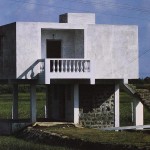In 1972 Ettore Sottssas Jr. imagines a domestic environment composed of a networked system of grey plastic containers, equipped with sliding wheels and plastic cables for reciprocal linking. Each container follows a function: a stove for cooking, refrigerator, wardrobe, shower room, the jukebox, library and a reading room. They represent a catalog of possibilities within which everyone can choose according to his own culture, and also organize, through their grouping or removal, either a solitary or a collective experience of living space.
“Not only the containers can be grouped or dissolved, but they can also take continuous configurations, or be snake-like, stiffened as Chinese walls, create transparent or closed, narrow or deep or broad, open or short areas, they can thus draw the most suitable scenario for the drama one intends to carry our or is actually carrying out.”

The technical drawings, paintings and furniture are accompanied by a film, which enhances the utopian nature of the project: more a series of ideas that a finished product, an ideal scenario of collective coexistence and communal living typical of those years. The anti-commercial logic of the project is reflected in the building of a domestic space where the individual is not subjected to any bias of “possession” of objects. The functions of living are universalized, since everyone can simply choose to use what he feels necessary. The project moves an implicit critique to the bourgeois household and foster the ideal of an emancipated woman which is free from the daily routine of cleaning the house or cooking. Instead, the collective, anarchic experience leaves to the individual the choice of how to live the domestic space. Sottsass said about the Mobile and Flexible Environment : “The idea is that anyone who lives in the midst of this furniture can bring them closer or move them away from his family whenever he wants to do it: so that he can manifest his feelings through the furniture, either if he’s in a solitary or in a group adventure, because the states, needs, dramas, joys, illnesses, births and deaths also take turns in the spaces.”



The film often describes oniric and dreamlike situations (probably recalling drugs’ use), and frequently adopts decoupages inspired by horror or crimes movies, in sequences of images without a unity of time, place and narrative. This brought Peter Lang, Luca Molinari and Mark Wasiuta, which have recently shown these films to the public after more than forty years of their production, to give credit to the Director Magri for staging a perfect Brechtian theater, denuded of distracting contexts.
Informations from ” Design e comunicazione audiovisiva industriale”, a thesis by Matteo Riva at the Politecnico di Milano (2009-2010) whose text is downloadable here.
Images via: Koichi Yanagimoto‘s Utopia board on Pinterest. (Images with texts are from Rassegna Magazine)
Previously on Socks: ETTORE SOTTSASS JR. – THE PLANET AS A FESTIVAL, 1972















[…] at 1972’s “Italy, the New Domestic Landscape” (also, here). (Cf. our articles on Sottsass‘s and Joe Colombo‘s furnitures domestic environments in […]